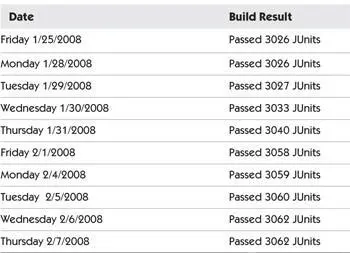Crispin, Lisa - Agile Testing - A Practical Guide for Testers and Agile Teams
Здесь есть возможность читать онлайн «Crispin, Lisa - Agile Testing - A Practical Guide for Testers and Agile Teams» весь текст электронной книги совершенно бесплатно (целиком полную версию без сокращений). В некоторых случаях можно слушать аудио, скачать через торрент в формате fb2 и присутствует краткое содержание. Год выпуска: 2008, Издательство: Addison-Wesley Professional, Жанр: Старинная литература, на английском языке. Описание произведения, (предисловие) а так же отзывы посетителей доступны на портале библиотеки ЛибКат.
- Название:Agile Testing: A Practical Guide for Testers and Agile Teams
- Автор:
- Издательство:Addison-Wesley Professional
- Жанр:
- Год:2008
- ISBN:нет данных
- Рейтинг книги:4 / 5. Голосов: 1
-
Избранное:Добавить в избранное
- Отзывы:
-
Ваша оценка:
- 80
- 1
- 2
- 3
- 4
- 5
Agile Testing: A Practical Guide for Testers and Agile Teams: краткое содержание, описание и аннотация
Предлагаем к чтению аннотацию, описание, краткое содержание или предисловие (зависит от того, что написал сам автор книги «Agile Testing: A Practical Guide for Testers and Agile Teams»). Если вы не нашли необходимую информацию о книге — напишите в комментариях, мы постараемся отыскать её.
Agile Testing: A Practical Guide for Testers and Agile Teams — читать онлайн бесплатно полную книгу (весь текст) целиком
Ниже представлен текст книги, разбитый по страницам. Система сохранения места последней прочитанной страницы, позволяет с удобством читать онлайн бесплатно книгу «Agile Testing: A Practical Guide for Testers and Agile Teams», без необходимости каждый раз заново искать на чём Вы остановились. Поставьте закладку, и сможете в любой момент перейти на страницу, на которой закончили чтение.
Интервал:
Закладка:
Why We Need Metrics
There are good reasons to collect and track metrics. There are some really bad ones too. Anyone can use good metrics in terrible ways, such as using them as the basis for an individual team member’s performance evaluation. However, without metrics, how do you measure your progress?
When metrics are used as guideposts—telling the team when it’s getting off track or providing feedback that it’s on the right track—they’re worth gathering. Is our number of unit tests going up every day? Why did the code coverage take a dive from 75% to 65%? It might have been a good reason—maybe we got rid of unused code that was covered by tests. Metrics can alert us to problems, but in isolation they don’t usually provide value.
Metrics that measure milestones along a journey to achieve team goals are useful. If our goal is to increase unit test code coverage by 3%, we might run the code coverage every time we check in to make sure we didn’t slack on unit tests. If we don’t achieve the desired improvement, it’s more important to figure out why than to lament whatever amount our bonus was reduced as a result. Rather than focus on individual measurements, we should focus on the goal and the trending toward reaching that goal.
Metrics help the team, customers included, to track progress within the iteration and within the release or epic. If we’re using a burndown chart, and we’re burning up instead of down, that’s a red flag to stop, take a look at what’s happening, and make sure we understand and address the problems. Maybe the team lacked important information about a story. Metrics, including burndown charts, shouldn’t be used as a form of punishment or source of blame. For example, questions like “Why were your estimates too low?” or “Why can’t you finish all of the stories?” would be better coming from the team and phrased as “Why were our estimates so low?” and “Why didn’t we get our stories finished?”
Metrics, used properly, can be motivating for a team. Lisa’s team tracks the number of unit tests run in each build. Big milestones—100 tests, 1000 tests, 3000 tests—are a reason to celebrate. Having that number of unit tests go up every day is a nice bit of feedback for the development and customer teams. However, it is important to recognize that the number itself means nothing. For example, the tests might be poorly written, or to have a well tested product, maybe we need 10,000 tests. Numbers don’t work in isolation.
Lisa’s Story
Pierre Veragen told me about a team he worked on that was allergic to metrics. The team members decided to stop measuring how much code their tests covered. When they decided to measure again after six months, they were stunned to discover the rate had dropped from 40% to 12%.
How much is it costing you to not use the right metrics?
—Lisa
When you’re trying to figure out what to measure, first understand what problem you are trying to solve. When you know the problem statement, you can set a goal. These goals need to be measurable. “Reduce average response time on the XYZ application to 1.5 seconds with 20 concurrent users” works better than “Improve the XYZ application performance.” If your goals are measurable, the measurements you need to gather to track the metrics will be obvious.
Remember to use metrics as a motivating force and not for beating down a team’s morale. This wisdom bears repeating: Focus on the goal, not the metrics. Maybe you’re not using the right metrics to measure whether you’re achieving your team’s objectives, or perhaps you’re not interpreting them in context. An increased number of defect reports might mean the team is doing a better job of testing, not that they are writing more buggy code. If your metrics aren’t helping you to understand your progress toward your goal, you might have the wrong metrics.
What Not to Do with Metrics
Mark Twain popularized the saying, which he attributed to Benjamin Disraeli, “There are three kinds of lies: lies, damned lies, and statistics.” Measurable goals are a good thing; if you can’t gauge them in some way, you can’t tell if you achieved them. On the other hand, using metrics to judge individual or team performance is dangerous. Statistics by themselves can be twisted into any interpretation and used in detrimental ways.
Take lines of code, a traditional software measuring stick. Are more lines of code a good thing, meaning the team has been productive, or a bad thing, meaning the team is writing inefficient spaghetti-style code?
What about number of defects found? Does it make any sense to judge testers by the number of defects they found? How does that help them do their jobs better? Is it safe to say that a development team that produces a higher number of defects per lines of code is doing a bad job? Or that a team that finds more defects is doing a good job? Even if that thought holds up, how motivating is it for a team to be whacked over the head with numbers? Will that make the team members start writing defect-free code?
Communicating Metrics
We know that whatever we measure is bound to change. How many tests are running and passing? How many days until we need a “build on the shelf”? Is the full build passing? Metrics we can’t see and easily interpret aren’t worth having. If you want to track the number of passing tests, make sure that metric is visible in the right way, to the right people. Big visible charts are the most effective way of displaying metrics we know.
Lisa’s Story
My previous team had goals concerned with the number of unit tests. However, the number of unit tests passing wasn’t communicated to anyone; there were no big visible charts or build emails that referred to that number. Interestingly, the team never got traction on automating unit tests.
At my current company, everyone in the company regularly gets a report of the number of passing tests at the unit, behind-the-GUI, and GUI levels (see Tables 5-1 and 5-2 for examples). Business people do notice when that number goes down instead of up. Over time, the team has grown a huge number of useful tests.
—Lisa
Table 5-1 Starting and Ending Metrics

Table 5-2 Daily Build Results

Are your metrics worth the trouble? Don’t measure for the sake of producing numbers. Think about what you’ll learn from those numbers. In the next section, we consider the return on investment you can expect from metrics.
Metrics ROI
When you identify the metrics you need, make sure you can obtain them at a reasonable cost. If your continual build delivers useful numbers, it delivers good value. You’re running the build anyway, and if it gives us extra information, that’s gravy. If you need a lot of extra work to get information, ask yourself if it’s worth the trouble.
Lisa’s team went to a fair amount of trouble to track actual time spent per story versus estimated time. What did they learn other than the obvious fact that estimates are just that? Not much. Some experienced teams find they can dispense with the sprint burndown chart because the task board gives them enough information to gauge their progress. They can use the time spent estimating tasks and calculating the remaining hours on more productive activities.
This doesn’t mean we recommend that you stop tracking these measurements. New teams need to understand their velocity and burndown rate, so that they can steadily improve.
Читать дальшеИнтервал:
Закладка:
Похожие книги на «Agile Testing: A Practical Guide for Testers and Agile Teams»
Представляем Вашему вниманию похожие книги на «Agile Testing: A Practical Guide for Testers and Agile Teams» списком для выбора. Мы отобрали схожую по названию и смыслу литературу в надежде предоставить читателям больше вариантов отыскать новые, интересные, ещё непрочитанные произведения.
Обсуждение, отзывы о книге «Agile Testing: A Practical Guide for Testers and Agile Teams» и просто собственные мнения читателей. Оставьте ваши комментарии, напишите, что Вы думаете о произведении, его смысле или главных героях. Укажите что конкретно понравилось, а что нет, и почему Вы так считаете.












